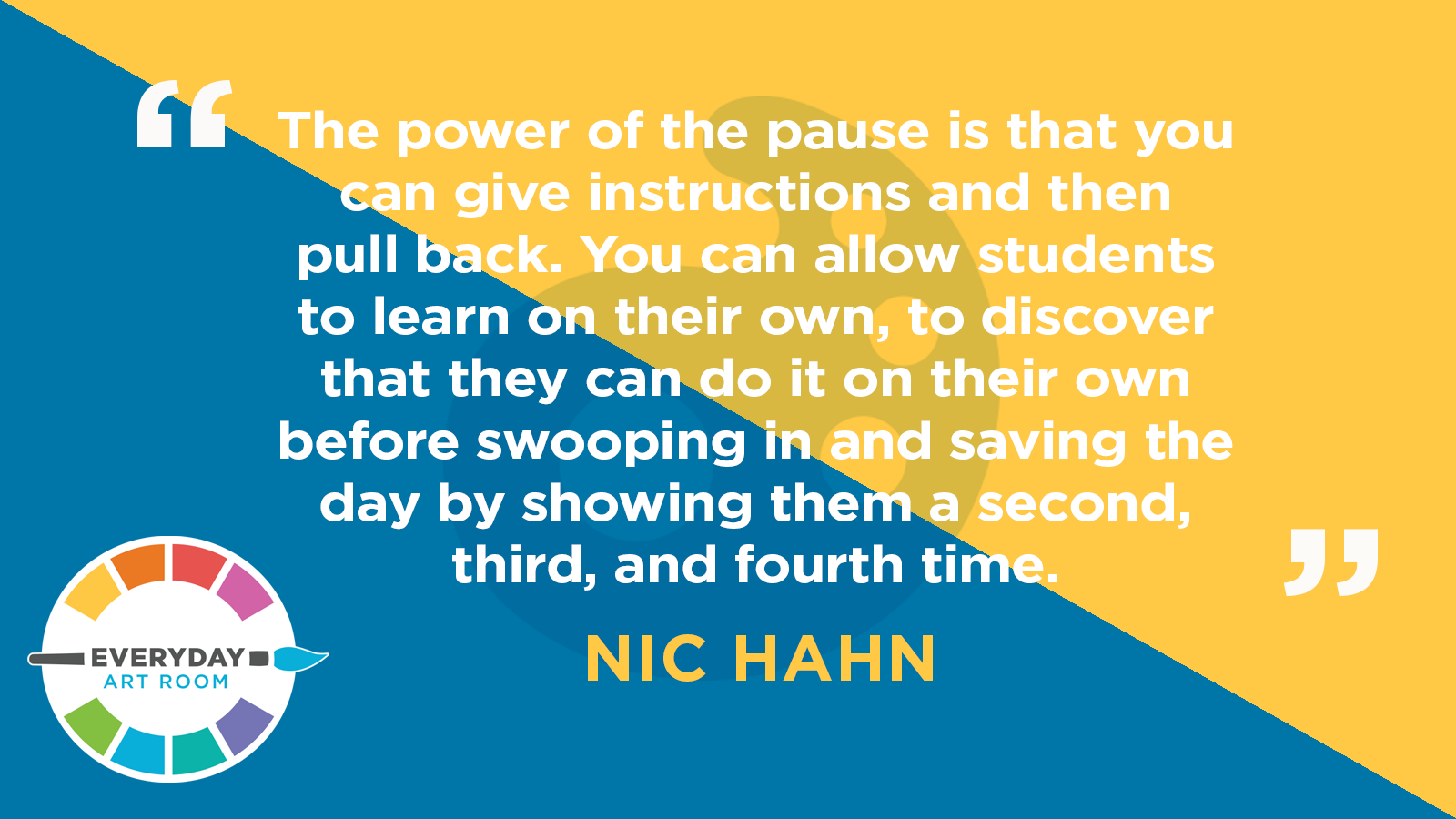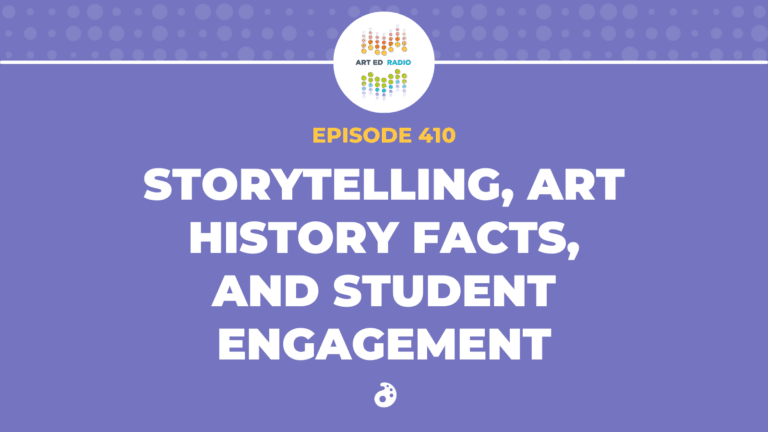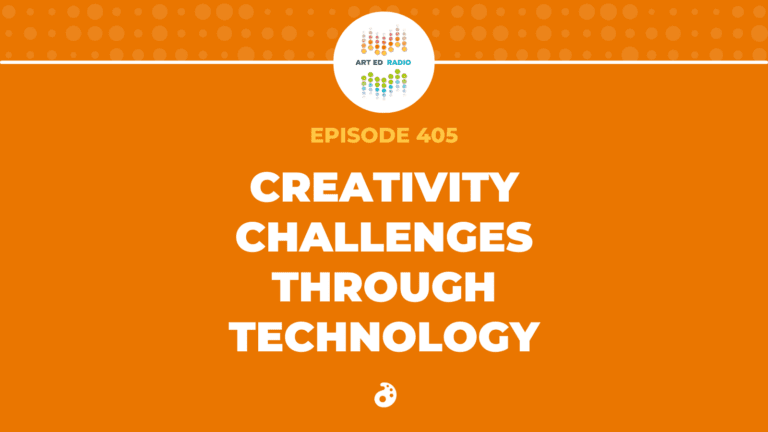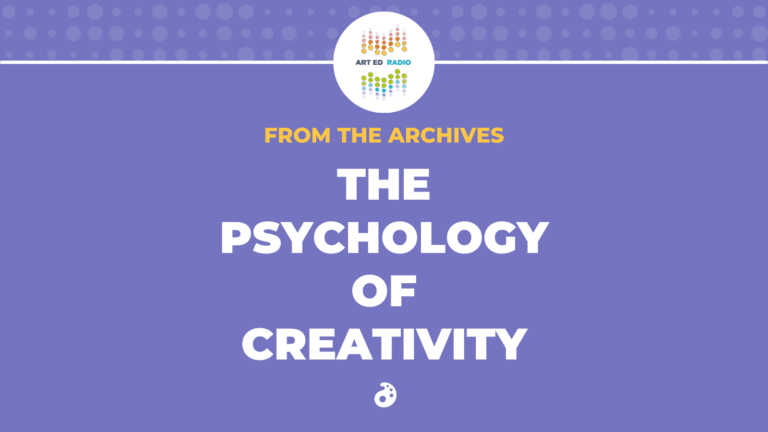One of the hardest things for teachers to do is to give students wait time. But that pause–that wait–can be a powerful tool in learning and self-discovery. In today’s episode, Nic talks about the power of the pause and how it helps her students when sewing, when discussing art, and when learning in all different ways. Full Episode Transcript Below.
Resources and Links
- Jack Richeson Paint Set
- Chenille Large-Eye Needles
- Studio: Fibers Graduate Course
- PRO Packs: Hand Sewing, Sewing Basics, and Advanced Fibers

Transcript
Nic: I’ve been posting quite a bit about a project that I’m doing with my fourth grade. It’s a sewing project. We are working on an embroidery loom. I’m loving it. I’ve not used the embroidery loom, but I have sewn with fourth grade for many, many years. I think fourth grade is a great year to introduce actual sewing of fabric to students. I think it’s just a great, great year to introduce that. So students are about nine, 10 years old, and I think this is a great time to do this. In the past, I’ve brought in volunteers. This year, I’m rocking it solo. My class sizes are still big, so I’m being asked, “How are you doing this? How is it working?” Today, we’re going to talk about that, but it’s not the answer that you might think. We will talk about the logistics of sewing, but there is something more to it. Here is the secret. I don’t do anything. Go ahead, continue to listen to allow me to understand what I’m talking about. This is Nick Hahn, and this is Everyday Art Room.
Often when we’re teaching students, we give the instructions, the students go off and do it, and then their hands immediately go up and they say, “I don’t know. I don’t know how to do it. I’m nervous. I don’t want to do it. I’m scared. I don’t know. Help me, help me, help me.” Today, we’re going to talk about first the logistics of sewing, and then we’re going to talk about the pause. I’m going to encourage you for any lesson, but we’re going to use sewing as an example, to give them instructions and then pull back, allow students to have that self-discovery, to learn on their own, to discover that they can do it on their own before swooping in, saving the day and showing them a second, third, fourth time.
I want to talk about the logistics first of what it looked like when we were kind of getting our supplies ready for sewing. So I’ve already got the students excited. We’ve talked about sewing. I’ve talked to them about my son being a person who sews. So they’ve talked about their memories and their family members who like to sew. They are ready. They come into the classroom. They’re ready to go. So what we did was we first, I handed each of the students some muslin. Muslin is a fabric that it has a loose enough weave that it allows students to easily put their needle through when we’re doing our sewing, but it has a tight enough weave that it doesn’t lose its shape easily. So I gave them, I think, it’s about eight by eight is the size that each student received, and that is going to fit nicely in the back of their sketchbook. I know you’re probably thinking, why do we need our sketchbook when we’re sewing? But what I did was I wanted students to be able to paint their fabric before we actually use this.
Now, in this case, when I’m having the students do is we’re doing a character’s face. So I’m asking the students to create a skin tone on the muslin itself. So we opened up our sketchbooks to the back page, and on the back of our sketchbooks, we have a nice sturdy cardboard back. And so, they place their muslin down on the cardboard and they used a piece of masking tape for the top and for the bottom, almost spanning the whole eight inches. Then they use the tape itself and placed it down and used their pencil to draw around the masking tape shape. That was just roughly larger than the four-inch embroidery hoops that we were going to be using. I wanted it just a little bit bigger so that it would give them a little bit larger surface than what they’re actually going to be using when we put it on the embroidery hoops.
Then I gave them the paints that they would take to paint over their neutral muslin color. As I mentioned, we’re creating a character, so I wanted them to have the different skin tones to change their character to be whatever skin tone they so choose. I use something called Jack Richeson is the brand. Richeson is R-I-C-H-E-S-O-N. Again, all of these will be in the podcast notes. It is mini tempera cake multicultural set that I get from Jack Richeson. You can buy it from many outlets, including Amazon. I ordered mine from Nasco, so it’s at craft supply stores or any of the art supply stores. And I liked them because of the set, because of the colors that are involved.
A lot of the students did a base color, and they even use the darker tones to put in the cheek areas so it allowed them to have kind of this rosy cheek looking kind of technique. It’s been very beautiful to see how they addressed the skin tones. If the students had extra time, they also took that circle shape of the masking tape and they placed it on the sheet of paper, which was directly next to the back, the cardboard, and they drew it over on the left-hand side. So imagine that, and then they were able to draw their preplan, if they had extra time, of the character’s face that they’re going to be sewing in the near future.
When they were finished, or when the hour was finished, they put it all onto the drying rack to allow the muslin to dry. And then at the end of the day, I was able to close all of the sketchbooks easily and put them in storage until the next time the students came into class. Now, the students are just simply getting back their sketchbooks, as we have practiced many, many, many times since third grade, and they already have their muslin. We don’t have to go through trying to hand back all these little pieces of fabric. So that was a really good method of getting back the muslin to every student.
The following week comes and I had the students spend a little bit of time just working on getting the fabric into the embroidery hoop. That became a lesson in itself. I’d say probably a 20 to a half-hour lesson in itself. So I had the students watch the video that I created for them. The video that I’m referring to, I have the full video on TPT. That is not why we’re doing this lesson. I’m just saying that the video that I created, I’ll allow us, any time that I create something that is very delicate, very close up, I create a video so that students can see the very minute movements that I’m doing and can see the small movements, like in this case, the untwisting of the top of the embroidery hoop and the stringing of the needle. That sort of thing can be seen very well on a very large projection.
So they are actually seeing me do this up on the board. And then they each get an embroidery hoop. They remove their muslin from the back of the sketchbook and throw away the tape. They put their muslin on the embroidery hoop, and I asked them to help one another. A lot of students want to come to me right away. This is where I give them the first practice of an, “I’m not going to help you.” And the first thing that they do is they will, some, not all, some students will try to come to you. You say this to begin with, you’re going to give them this pep talk, “I know you can do this. That’s why I’m asking you to try. I know I believe in you. I believe that there are some helpers in here. If you give it a try several times and you can’t do it, ask your friends to help you. And they’re not going to help you by doing it for you. They’re going to help you by watching you and encouraging you.”
So you might even demonstrate that. You might say, “I’m going to help and encourage someone. This is how I’m going to do it. Put your hands behind your back and sit next to someone and say, ‘You can do it. That’s right. You twist that part. That’s right. Excellent. Now, you put that. Yes, you put that on top right like that. You press it down. Nice job.’ Notice my hands are behind my back the whole time.” It’s really fun to watch peers help peers with their words. It’s really fun. And you know what? Some kids are going to help with their hands. And you’re going to just pretend like you don’t even see that. But most students are going to find success even with that encouragement. And most students are going to find success, because you’ve already said, “I know you can do it because I know you can. That’s why I’m asking you to do it.”
So as you give them the embroidery hoops, they’re going to go back and eagerly and give this a try. You watch them do it. Sometimes I did have a little bucket of five needle-nose pliers, and I said, “If it’s really hard to twist, you might need this tool. I have five of them. At the end of today, I want five of them back up here.” Some people just love using tools, so that might be encouraging for them. They might want to just try using the tool. So it’s nice to have them there. They’ll go up there and they’ll use it and they’ll undo it. And it’s fun. It’s fun to sit back and watch. And you just stand there. You stand in the front of the room and you monitor. You’re not helping anyone. You’re not allowing that student to go back and come immediately to you and say, “Help me. I can’t.” And if they do, you say, “You can. Give it a try,” or you give them that smile because you’ve already said those words to them. You allow them the time to give it a try.
All right, so students are now actively putting this in the embroidery hoop and they’re going around to different stations in my classroom. So I add a station for buttons and they were gathering buttons. I had a station for felts. I have a station for yarn, so they were kind of grabbing some yarn. These were the other things that they could add to their design. And I also have now, I just recently had donated these… They’re packaging that you can put in the mail like you have for Amazon or something. So it’s not bubble packaging. It’s kind of this rubbery packaging. And it fits perfectly a whole sketchbook and has a little bit of extra room. And so, we’re going to be able to put the sketchbook in, our embroidery hoops and all of the felt that they want, the buttons that they want. Everything’s going to fit in this one little bag, and they’re going to put their name on it.
Now, I don’t know if you’ll be able to get that, but maybe you’ll be able to find something like an envelope of some sort where everything can go into it and you can have everything contained. So maybe a baggie with their names on it, something to put all the things that they’re going to want next time. And then, if they had extra time during this hour, they could go back into their sketchbook and now add color to their preplan or change some of the ideas. If they found the perfect buttons to add for the cheeks or add earrings or add in the hair, they could redraw some of those things, redraw their whole idea now that they know the materials that they have to add to their product next time. So they’re adding their embroidery hoop and they’re redrawing their design now that they have the materials. This is going to allow them to come in the very next time and start sewing and getting going on their project.
Okay. We finally made it to sew day. Again, let’s talk about the logistics first. So we have our embroidery hoop. We have all the things now where I’m going to show them how to actually sew. The materials that we need on this day, I have large eye needles. I like using chenille needles. That is a hard thing to say. I’ve practiced it several times. Chenille needles are like tapestry needles. They’re metal, the ones that I use. They have a large eye to them. I like using them because they’re sharp and students will often ask, “Are these going to be sharp?” “Yep. They are. You’ll be careful and you’ll be able to do this. I believe in you. You can poke your finger, but it’s okay. You’ll be okay.”
And so, chenille needles. And then I use, for the string part, I use a crochet string. I find the twist in it allows it to hold itself a little bit better than some other strings that I’ve used so it doesn’t fray as much. It does fray a little bit. We’ll talk about that in just a second. So I give them the video that shows them how to make their knot at the end. I tell them, and this is where it might be beneficial to watch the videos that I have created, but I show them to pinch, with their pointer finger and their thumb the crochet string and pop it up to get it into the needle. I have shown them how to use a piece of paper to bring it through the eye of the needle as well. For these huge eye crochet needles, I haven’t found that to be an issue.
And guys… I say guys. I’m trying not to do that. Okay, penny in the penny jars. Sorry. If there is one silver lining in COVID, it’s those masks not allowing the string to go into the student’s mouth. Truly, nobody’s doing that right now. They’re not sucking on the string to make it wet so that they can slip it into the needle, so that’s a good thing I guess. What I’m noticing is that students are trying to get it into the needle without, or the eye of the needle without putting slobbering on it, so that’s good.
Okay. Most students are able to do this without doing any adaptations. I have taken the time to do a little, tiny slip of a piece of paper, folding that piece of paper, putting that through the eye of the needle, with the string and pulling it through, possibly I’ll have to do an Instagram right around the time that this episode drops. Maybe I’ll try to write that down to explain this better, but using a piece of paper to help students sometimes helps. But I’ve noticed that this adaptation often is dropped to the wayside because it’s another thing. Most students end up just placing it through with practice.
So they put the string through the eye of the needle. I show them how to make a circle and take the tail of the circle to pop the balloon, pop the circle, to make a knot, do that twice. That’s what happens to the long tail of the string. And then we start from the back. So up to the top, pull the string all the way through, put it back down through the fabric, through the muslin, pull it through, through, through, through until the string goes all the way through, and so on, up, down, up, down until it goes all the way through, and then I show him how to knot it off on the back.
Okay, that sounds complicated in verbal terms. In the video, it works much better. I would recommend making a video that shows your hands doing this. It just works a lot better, of course. But here’s the main point of this whole podcast. When I tell them and show them this, I say, “Guys…” Of course, I did it again. I’m saying I am working on this, this whole guys thing. I must use this a lot more, this term a lot more than I give myself credit to. If you don’t know what I’m talking about, listen to about three, four podcasts back. You’ll understand. I’m collecting quite a penny jar right now. I don’t know where I’m going to donate all this money. Okay. Dear listeners, I’m telling you that this is where the money is at.
You tell your students that you are going to be sitting back and not helping them for 15 to 20 minutes. You explain that people in general, not just students, find sewing hard the first couple of times that they try it. It’s going to be hard, but you’re going to practice and practice and practice, and it’s going to get easier every single time that you do this. And it will be hard, but man, it’s going to feel so good when you accomplish everything that you accomplished today, you’re going to feel so excited to be able to go home and say, “Guess what I did?” Okay. For the next 20 minutes, I’m going to be working on such and such. And you’re going to be working on your job. After 20 minutes, I’m going to say, “Anyone who doesn’t have a stitch inside their muslin, I’d like you to come up to me and we’ll work on it together.” Are you guys ready? All right, go. Shoot. I also have to add another penny in. Okay.
So students go back to their tables and they start sewing. I do release tables one at a time. I allow just four or six people up to get the string. And it’s very organized to begin with and then it becomes a little bit more organic as students need more string. It doesn’t become such a bottleneck. And there is frustration and sometimes there is tears, but I’m keeping my hands busy as I’m monitoring the room. I’m pretending to be working on something, even though I’m not really working on anything. I’m monitoring the room for the most part, but I’m allowing self discovery. And because I’ve given them the pep top talk of, “Yes, it’s going to be hard.” It is for some students, but I’m watching the students try and I’m watching them try again and I’m watching them try again, and students are finding success.
And even the students that are struggling to begin with are starting to find more success as they continue. And some kids aren’t finding that success, and that’s okay because after 15 or 20 minutes of them trying, I invite students up by me. And I don’t go to them. I have them come away from their friends, away from that location of frustration. And I say, “Bring your needles up by me,” and usually I don’t even have that be a table. I have it on the floor. I’m sitting criss-cross and I’m being calm. I have a quiet voice. “If you’re having a hard time, come up by me.” And we have a quiet little space. Sometimes some classes, this is 10 kids and I help one at a time. And a lot of times the same questions I’m helping and I’m helping.
Let’s see. Maybe it’s, “How do I do this knot?” And I’ll put the piece of yarn or crochet string down in the center. And I’ll say, “Let’s do this together. Let’s watch.” And then that might be enough to help two kids. They figure it out right away and they go back and start working. Then, now I’m down to eight kids. Or in some classes, it’s just two kids that come up right away. Now it’s just me, two kids, and everybody else in the room is sewing. Taking that pause, allowing self discovery has been the number one trick for any of my lessons. Allowing students to have self discovery and not rushing to help them right away is my number one trick for today.
Man, oh man, I thought that this podcast would be all about talking about that wait time and allowing self discovery, and it was really all about sewing and the logistics of sewing. But really I want you to pay attention to that tiny little message at the end. It’s the one place that I wish, I recently, I told you in the past couple of episodes, I’ve had a student teacher recently, and it’s the one place that I didn’t demonstrate enough. I wish I would have given that gift of pause and self discovery to my student teacher a little bit better. I wish I would have shown Ms. Mullen how to sit back and allow students to have self discovery instead of me swooping in and fixing the problem and showing them that one-on-one how to make it better. I wish I would have allowed that self discovery a little bit better.
I mentioned a lot of resources that I have for you, but what I did not mention is all the resources the Art of Education has for you. If you are looking to so in your classroom, and there is an abundance, an abundance of fibers lessons on the magazine, there’s a ton of lessons and tips and tricks on the magazine. I have taken the fibers course, which is awesome. I love the studio courses that AOEU has for either just to take to take or through their master’s program. The studio courses are absolutely my favorite courses that I’ve taken. I’ve topped out on all the courses that I need to take for my career. It doesn’t mean that I am not taking courses anymore, but my favorite are the studio courses through the Art of Education University.
And then, of course, there’s plenty of pro packs that are all about fibers. And specifically, I know that Cassie Stephens has some on sewing, and she talks about that whole threading and sewing and that sort of thing. So check out some of the pro packs. I think we even have some more recent Cassie’s where some of the original pro packs. I think we have some other voices talking about sewing as well. So definitely check in to those if you’re looking for more information on bringing fibers into your classroom as well.
Magazine articles and podcasts are opinions of professional education contributors and do not necessarily represent the position of the Art of Education University (AOEU) or its academic offerings. Contributors use terms in the way they are most often talked about in the scope of their educational experiences.



